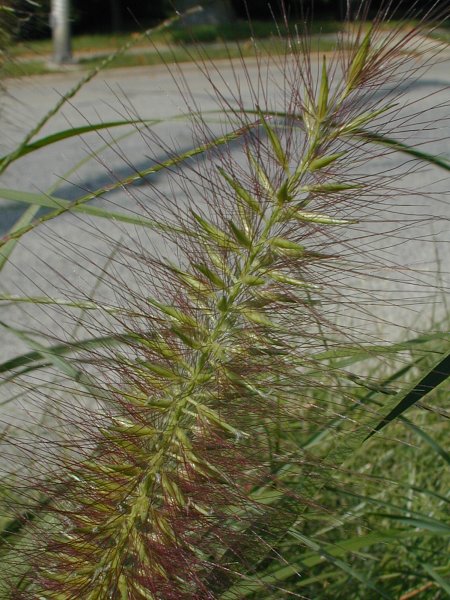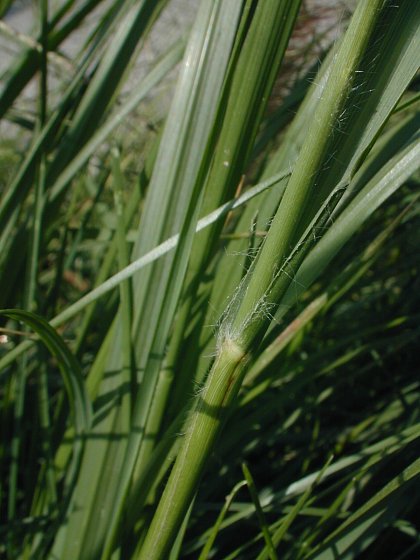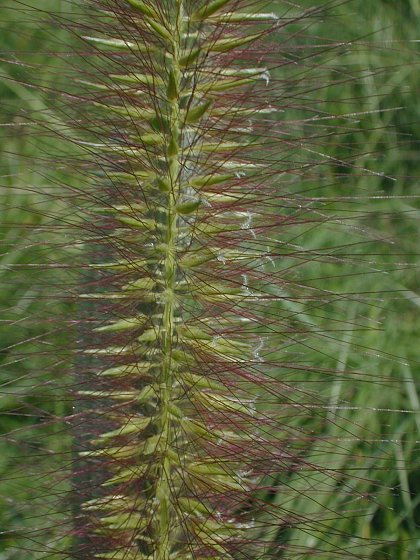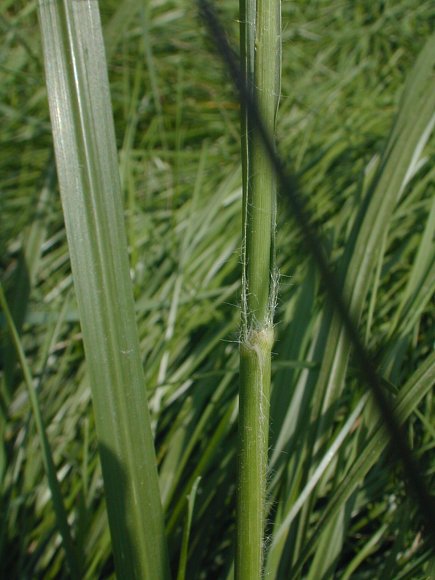
Each spikelet consists of a short glume (0.5-2.0 mm. in length), a long glume (2-4 mm. in length), a sterile lemma, and a fertile lemma with a perfect floret. Both lemmas are about the same length as the spikelet (5-8 mm. in length), light green (while immature), glabrous, and longitudinally veined. The perfect florets have 3 anthers and a pair of feathery white stigmata. Originating from the base of each spikelet, there are 10-30 bristles. The longer bristles are ¾-1½" in length, while shorter bristles are about the same length or a little longer than the spikelets. These bristles are light green or reddish purple (during the blooming period), relatively straight, and glabrous. The blooming period occurs during late summer or early fall, lasting about 2-3 weeks. The florets are cross-pollinated by the wind. At maturity, the spike-like racemes or panicles become white, tan, or light green; each spikelet contains a single grain. The grains are 2.5-3.0 mm. in length and ellipsoid-oblongoid in shape. They are dispersed to some extent by the wind. The root system is fibrous and short-rhizomatous.

Cultivation: The preference is full to partial sun, moist to mesic conditions, and soil containing fertile loam with decaying organic matter. This grass is easy to cultivate. It is hardy to about Zone 5, although there may be some variation in its tolerance to winter cold, depending on the cultivar. While this grass prefers relatively moist situations, it is able to tolerate considerable heat and occasional periods of dryness because of its C4 metabolism. Most growth and development occurs during the warm weather of summer.
Range & Habitat: The non-native Chinese Fountain Grass rarely occurs in Illinois as a naturalized plant. So far, such plants have been encountered in only 2 counties of the state (see Distribution Map). Because of its widespread cultivation as an ornamental grass, it seems likely that escaped populations of Fountain Grass will be found in additional counties in the future. This grass is native to East Asia and possibly Australia. Habitats in Illinois consist of grassy areas along roadsides. Outside of the state, this grass has been found on grassy hillsides, meadows, roadsides, edges of fields, ditches, and swampy areas.

Faunal Associations: Very little is known about floral-faunal relationships for this grass in North America. An aphid, Sipha flava (Yellow Sugar Cane Aphid), sucks juices from the leaf blades of Pennisetum spp. (Fountain Grasses). The young foliage of Chinese Fountain Grass is edible to livestock and other hoofed mammalian herbivores. Because of the long bristles on the spikelets, the grains of this grass may be dispersed in part by animals. In addition, the wind generated by passing motor vehicles may blow the grain-bearing spikelets up and down roadways.
Photographic Location: A grassy area along a street in Urbana, Illinois.

Comments: Another common name of Pennisetum alopecuroides is Swamp Foxtail Grass; this name originates from Australia. The bottlebrush seedheads of Chinese Fountain Grass are very distinctive and ornamental, therefore it is hardly surprising that this grass is widely cultivated. There are several cultivars of this grass that vary significantly in their physical appearance. In particular, some cultivars are smaller in size than others, and they can vary in the colors of their seedheads. The Fountain Grass that has been photographed here is one of the larger cultivars with purplish bristles. It does not closely resemble any other grass in Illinois, whether native or naturalized. The only other species in this genus that has been found within the state, also naturalized, is Pennisetum americanum (Pearl Millet), but the spikelets of this species lack the long spreading bristles of Chinese Fountain Grass. Pearl Millet is an annual species that has been cultivated in Africa as a grain crop for thousands of years.